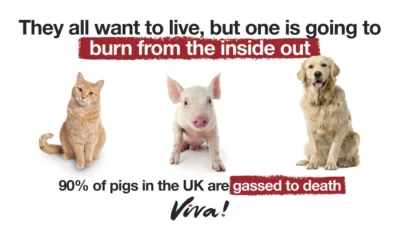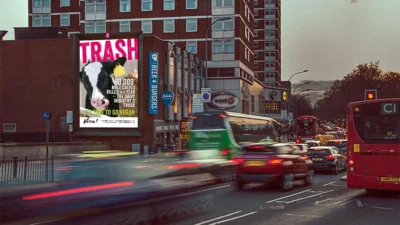World Hunger

One in nine people in the world today are undernourished, yet we feed around a third of our global crop production to animals. If we cut out the middleman and ate the crops ourselves, instead of feeding them to animals, we could feed an additional four billion people – more than enough for everyone, for many years to come! We all know how wasteful old gas-guzzling cars are – how long before livestock farming is viewed in the same way: As a shameful, inefficient waste of resources.
Around one-third of global cropland is used to grow animal feed.1FAO. 2006. Livestock’s Long Shadow. ftp://ftp.fao.org/docrep/fao/010/A0701E/A0701E00.pdf Feeding crops to animals instead of people is a highly inefficient way of producing food. When plant-based foods are transformed into animal protein, most of the protein and energy contained in them are lost; used by the animals for their metabolic processes and to build non-edible tissue like bones, cartilage and offal, and lost in faeces.2Baroni L, Cenci L, Tettamanti M et al. 2007. Evaluating the environmental impact of various dietary patterns combined with different food production systems. European Journal of Clinical Nutrition. 61 (2) 279-286.
Writing in the journal Nature, a team led by Dr Jonathan Foley, director of the Institute on the Environment at the University of Minnesota, said: “Today, humans are farming more of the planet than ever, with higher resource intensity and staggering environmental impacts; while diverting an increasing fraction of crops to animals, biofuels and other non-food uses. Meanwhile, almost a billion people are chronically hungry. This must not continue: the requirements of current and future generations demand that we transform agriculture to meet the twin challenges of food security and environmental sustainability.”
“Using highly productive croplands to produce animal feed – no matter how efficiently – represents a net drain on the world’s potential food supply.”3Foley JA, Ramankutty N, Brauman KA et al. 2011. Solutions for a cultivated planet. Nature. 478 (7369) 337-342.
An increasing number of scientific studies and reports are recommending that people eat less meat; not just for health reasons and the environmental benefits of reducing consumption, but also because there would be far more food to go around. The UK government recommends eating no more than 70 grams of red or processed meat (two slices of bacon) a day, but does not specify a limit on white meat. In 2017, the average intake of red, processed and white meat combined (in the UK) was around 220 grams per day, compared to the world average of 117 grams per day. Consumption tends to be considerably higher in richer countries – although in Brazil (still considered a developing country), average meat consumption is actually higher than in Europe; at 271 grams per day compared to 214 grams per day, respectively.4FAOSTAT. 2020. Food and Agriculture Organisation of the United Nations. www.fao.org/faostat/en/#home
Over the last 50 years, the global population has doubled – from around three billion, to more than six billion people – but global food demand has tripled. This is because, as global incomes increase, living standards have also risen and the global demand for animal foods has increased – as these are seen as more luxurious food products. The shift to a more intensive demand for animal products is called the ‘Livestock Revolution’ and it is estimated approximately 40% of the world’s population will undergo this revolution towards more animal consumption by 2050.5Cassidy ES, West PC, Gerber JS et al. 2013. Redefining agricultural yields: from tonnes to people nourished per hectare. Environmental Research Letters. 8, 3. At the same time, obesity and related health problems are currently rising sharply and we now face the insane scenario where obesity is responsible for a similar number of premature deaths globally as hunger.6Bodirsky BL, Rolinski S, Biewald A et al. 2015. Global Food Demand Scenarios for the 21st Century. PLoS One. 10 (11) e0139201.

Being undernourished is defined as being underweight for one’s age, too short for one’s age (stunted), dangerously thin for one’s height (wasted), and/or deficient in vitamins and minerals (micronutrient malnutrition). The United Nations Food and Agriculture Organisation (FAO) said that in 2019, nearly 690 million people were hungry – or nine per cent of the world population – up by 10 million people in one year and by nearly 60 million in five years. The number of people affected by severe food insecurity shows a similar upward trend. In 2019, close to 750 million – or nearly one in ten people in the world – were exposed to severe levels of food insecurity.7FAO. 2020. The State of Food Security and Nutrition in the World 2020. http://www.fao.org/documents/card/en/c/ca9692en
The Zero Hunger Challenge was launched by UN Secretary-General Ban Ki-moon in 2012, its aim to achieve zero hunger in the world by 2030. The State of Food Security and Nutrition in the World is the most authoritative global study tracking progress towards ending hunger and malnutrition. It is produced jointly by the FAO, the International Fund for Agriculture, the United Nations Children’s Fund (UNICEF), the UN World Food Programme and the World Health Organisation (WHO). The 2020 report says that not only is the world not on track to achieve zero hunger by 2030 but also that adult obesity is on the rise in all regions. It is a truly crazy situation! According to current estimates, in 2019, 21.3 per cent (144 million) of children under five years of age were stunted, 6.9 per cent (47 million) were wasted and 5.6 per cent (38 million) were overweight.7FAO. 2020. The State of Food Security and Nutrition in the World 2020. http://www.fao.org/documents/card/en/c/ca9692en
The report describes how conflict and climate change (including extreme weather events) have undermined efforts to end hunger, food insecurity and malnutrition. In 2019, economic slowdowns and downturns also undercut efforts. In 2020, the Covid-19 pandemic, as well as unprecedented desert locust outbreaks in Eastern Africa, obscured economic prospects in ways no one could have anticipated. The FAO warns that the situation may only get worse if we do not act urgently and take unprecedented action to transform food systems to ensure that no one is constrained by the high prices of nutritious foods or the lack of income to afford a healthy diet, while we ensure that food production and consumption contribute to environmental sustainability.7FAO. 2020. The State of Food Security and Nutrition in the World 2020. http://www.fao.org/documents/card/en/c/ca9692en

Pressure on the world’s food supply in the coming years will continue to rise as the global population and subsequent demand for meat increases. Add to that the rise in demand for biofuels as we switch to cleaner energy and it is clear there will be a tremendous burden on the world’s croplands.5Cassidy ES, West PC, Gerber JS et al. 2013. Redefining agricultural yields: from tonnes to people nourished per hectare. Environmental Research Letters. 8, 3. Agriculture, say scientists, lies at the heart of this challenge as it is the world’s single largest driver of global environmental change.8Rockström J, Williams J, Daily G et al. 2017. Sustainable intensification of agriculture for human prosperity and global sustainability. Ambio. 46 (1) 4-17.
Improving crop yields might help a little, but it simply won’t be enough to prevent an increase in world hunger. However, it is already possible to dramatically increase the availability of food in the world by shifting the allocation of crops from animal feed and biofuels towards more direct means of feeding people. The US agricultural system alone could feed one billion additional people just by shifting crop calories to direct human consumption.5Cassidy ES, West PC, Gerber JS et al. 2013. Redefining agricultural yields: from tonnes to people nourished per hectare. Environmental Research Letters. 8, 3.
A shift towards sustainable agriculture is key to attaining the goal of eradicating hunger and securing food for a global population of over nine billion by 2050 – which may require a substantial increase in global food production of between 60-110%.8Rockström J, Williams J, Daily G et al. 2017. Sustainable intensification of agriculture for human prosperity and global sustainability. Ambio. 46 (1) 4-17.
As stated, feeding food that humans could eat to animals, so that humans can in turn eat them, is a waste of precious resources: 36% of the calories from crops are currently used for animal feed but only 12% of those feed calories find their way into the human diet as meat and other animal foods. 5Cassidy ES, West PC, Gerber JS et al. 2013. Redefining agricultural yields: from tonnes to people nourished per hectare. Environmental Research Letters. 8, 3.
Writing in the European Journal of Clinical Nutrition, scientists say: “If animals are considered as ‘food production machines’, these machines turn out to be extremely polluting, to have a very high consumption and to be very inefficient”. A large amount of energy is also used in the production of animal feed and the upkeep of animal husbandry facilities, from stables to slaughterhouses. The inefficiency of animal agriculture is revealed by measuring by the amount of energy it takes to produce each calorie of food. If we take into account fossil fuel consumption alone, scientists say production of one calorie from beef needs 40 calories of fuel; one calorie from milk needs 14 fuel calories, whereas one calorie from grains can be obtained from 2.2 calories of fossil fuels.2Baroni L, Cenci L, Tettamanti M et al. 2007. Evaluating the environmental impact of various dietary patterns combined with different food production systems. European Journal of Clinical Nutrition. 61 (2) 279-286.
Growing food solely for human consumption, without first feeding it to farmed animals, could increase available food calories by as much as 70%, which could feed an additional four billion people – more than the projected two or three billion predicted in population growth by 2050.5Cassidy ES, West PC, Gerber JS et al. 2013. Redefining agricultural yields: from tonnes to people nourished per hectare. Environmental Research Letters. 8, 3. There really is no excuse for wasteful Western diets.
In addition to rising meat and dairy demands, affluent nations are also channeling a growing proportion of high-value crops into biofuel production. Much of this could be eaten by people; especially maize produced in the US and sugarcane produced in Brazil. In 2010, global biofuel production represented 2.7% of global fuel for road transportation; which is more than a 450% increase from the year 2000.5Cassidy ES, West PC, Gerber JS et al. 2013. Redefining agricultural yields: from tonnes to people nourished per hectare. Environmental Research Letters. 8, 3.
We may have a global economy, but the huge disparities between the rich and the poor, and the persistent depletion of environmental resources used in food production on land and at sea, prevent us from reducing or even resolving the very basic public-health problem of world hunger.
So, if you choose to cut out the middleman (the cow, sheep, pig, chicken or fish) and get your calories directly from plant-based foods, world hunger really could become a thing of the past.




